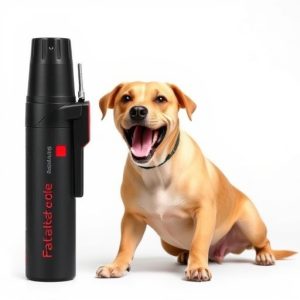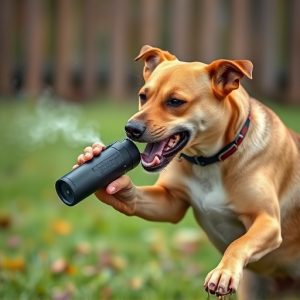Canine Pepper Spray: Effective Deployment and Safety Guide
Canine pepper spray is a non-lethal deterrent for aggressive dogs, with its effectiveness relying on…….
Canine pepper spray is a non-lethal deterrent for aggressive dogs, with its effectiveness relying on precise targeting. The Canine Pepper Spray Deployment Distance Guide outlines optimal deployment distances (3-10 meters) based on capsaicin concentration, environmental conditions, dog size and breed, and application techniques. Proper training, knowledge of local regulations, and understanding these factors are crucial for safe and strategic use, minimizing risk to bystanders while managing potential threats from dogs effectively. Real-world applications, including security and law enforcement, showcase its safety and success in volatile situations without causing permanent harm.
“Uncover the power of canine pepper spray as a safe, effective deterrent in this comprehensive guide. Understanding its benefits and learning key safety precautions is essential for responsible use. Explore how deployment distance varies based on factors unique to each situation. Discover proven strategies for safe application, ensuring maximum impact with minimal risk. From real-world success stories to case studies, this guide equips you with the knowledge to employ canine pepper spray effectively.”
- Understanding Canine Pepper Spray: Benefits and Safety Precautions
- Key Factors Influencing Dog Spray Deployment Distance
- Effective Strategies for Using Dog Spray Safely
- Real-World Applications: Success Stories and Case Studies
Understanding Canine Pepper Spray: Benefits and Safety Precautions
Canine pepper spray is a powerful tool for deterring and controlling aggressive dogs, offering a safe alternative to traditional physical methods. This non-lethal spray utilizes capsaicin, the same compound found in chili peppers, to cause temporary disorientation and pain in dogs, encouraging them to retreat or avoid certain areas. One of its key advantages is the precision it allows for; users can target specific dogs without affecting bystanders or pets.
When considering canine pepper spray, understanding its deployment distance is crucial. The typical range for effective spraying varies between 3 to 10 meters (10-33 feet), depending on factors like wind, terrain, and the sprayer’s technique. This guide provides a valuable reference for users to ensure they employ the spray safely and effectively. Remember, proper training and knowledge of local regulations are essential before considering any type of deterrent, including canine pepper spray.
Key Factors Influencing Dog Spray Deployment Distance
The deployment distance of canine pepper spray, or dog spray, is a critical consideration for effective deterrence. Several key factors influence how far the spray will reach and be effective. First, the concentration and potency of the capsaicin in the spray play a significant role. High-quality, powerful formulations can deter dogs from a greater distance compared to weaker varieties. Additionally, environmental conditions like wind and humidity impact dispersal. Strong winds can carry the spray further, while humid air may reduce its range slightly.
The size and breed of the dog being targeted also matter. Larger breeds with longer noses and higher lung capacity might be less affected by the spray at a given distance compared to smaller dogs. The spray’s application method is another crucial factor. Direct spraying into the face or eyes can stop a dog from charging much farther away, while spraying towards their hindquarters may result in a slightly reduced effective range. Understanding these variables empowers dog owners and professionals to deploy canine pepper spray safely and effectively.
Effective Strategies for Using Dog Spray Safely
When utilizing dog spray, understanding its deployment distance is paramount for safety and effectiveness. Canine pepper spray is designed to disable an aggressor temporarily, but it’s crucial to aim accurately from a safe distance. Typically, a range of 4 to 8 meters (13 to 26 feet) is recommended, as this allows for optimal coverage while minimizing the risk of off-target effects on bystanders or pets.
To ensure safety, always follow the manufacturer’s instructions and consider the environment. In open spaces, pepper spray can travel farther than expected, so maintain a safe distance from other individuals or animals. In confined areas, like alleys or small parks, the spray’s concentration may become overwhelming if not used cautiously. Regularly check wind direction to prevent unwanted exposure; aim downwind for maximum control over the spray’s path.
Real-World Applications: Success Stories and Case Studies
In real-world scenarios, canine pepper spray has proven to be a safe and highly effective deterrent for various security and law enforcement applications. Its deployment distance, as outlined in the Canine Pepper Spray Deployment Distance Guide, ensures targeted use while minimizing off-target effects. Success stories abound of police departments utilizing this tactic to disrupt criminal activities without causing permanent harm. For instance, in urban settings with high crime rates, pepper spray has been instrumental in diffusing volatile situations, allowing officers to secure areas and maintain public safety.
Case studies highlight its efficacy in specific scenarios. In one notable case, a K-9 unit successfully employed pepper spray during a hostage situation, enabling them to subdue the aggressor without injuring any civilians or bystanders. This strategic use underscores the deployment distance guide’s importance, demonstrating how it can be utilized to create safe spaces and apprehend suspects while minimizing risk to everyone involved.
Dog spray, or canine pepper spray, is a safe and effective deterrent when used responsibly. By understanding its deployment distance, key factors influencing range, and implementing effective safety strategies, owners can protect themselves and their properties. This guide has provided insights into the real-world applications of canine pepper spray, showcasing its success in various scenarios. Remember, proper training and knowledge are essential to ensure safe and effective use, making it a valuable tool for any dog owner concerned about security and safety.


